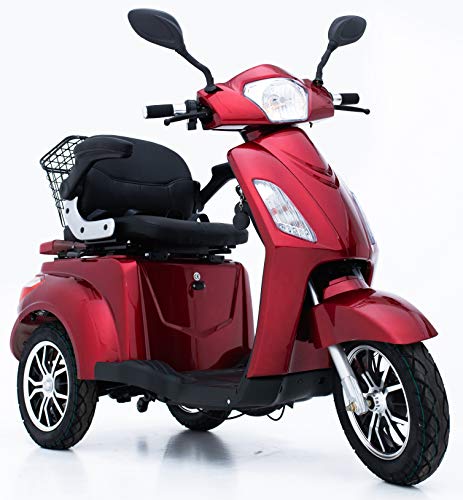9 Lessons Your Parents Taught You About Green Mobility
페이지 정보
작성자Don 댓글댓글 0건 조회조회 4회 작성일 24-12-17 21:13본문
 What Is green power electric mobility scooter Mobility?
What Is green power electric mobility scooter Mobility?Green Mobility develops corporate programs to reduce commute trips by private motor vehicles in cities. This does not just reduce congestion, but also improves the public transportation system and the quality of life.
Sustainable transportation options can help to minimize environmental impact and pollution and also be used to promote an active lifestyle that can bring health benefits. Examples of green mobility are:
Policy Interventions
A variety of policy instruments can help in promoting green mobility (korsholm-Payne-2.thoughtlanes.net). The first category includes spatial strategies that seek to limit the traffic of urban vehicles and encourage the use of sustainable transport modes. These are typically small-scale actions (e.g., restrictions on parking spaces, speed limits or the use of bicycle lanes) and have a high degree of flexibility, since they can be adapted to local conditions.
Another set of instruments for policy is designed to change the modal nature of travel by promoting alternative fuels and vehicle technologies (e.g. electric vehicles) or by encouraging the sharing of routes and vehicles. These policies could also include measures that increase the accessibility of public transportation services, for example through financial incentives or increased mobility options.
Furthermore the promotion of green mobility could require a change in business models and economic development and also an adjustment of transportation and land use planning. This requires political will and a high degree of coordination between different sectors. Additionally, it must be considered that a broad and equitable shift to green mobility is contingent on eliminating existing inequalities. In cities that have a high concentration of high-value sectors of employment such as business services, information and communications technology, expanding scooter green power mobility could lead to an increase in accessibility for communities of middle and upper classes, while also reducing opportunities and employment in communities with lower incomes.
A third set of policy instruments is designed to reduce negative externalities of transportation and promotes a sustainable energy supply, which includes renewable energy sources and carbon pricing. These policies can be enacted on a local, national or EU level. They could take the form of a fee or tax on vehicle ownership and operation or a more comprehensive regulation of vehicle usage. They could also aid in the development of electric scooter green vehicles as well as the charging infrastructure that supports them and promote a switch to more sustainable forms of mobility. Locally, this may mean implementing initiatives aimed at fostering sustainability and establishing a new habit through education, awareness campaigns and a range of other initiatives. At the national and EU level, this can include using global economic stimulus to encourage consumer purchase of EVs, expanding high-speed railway networks, as well as supporting research and development in hydrogen and batteries.
EV Adoption
The rate of transition between traditional internal combustion (IC) and electric power is based on a variety of factors. One factor is the economic situation of a country as well as its national policy. Norway and China have been historically the countries that have embraced EV production, with strong incentives for consumers. These financial incentives helped to create an energetic EV industry, which led to lower costs.
These countries also have strong energy policies that encourage sustainable energy usage. They also prioritize the building of a large public charging network to alleviate the range anxiety of new electric scooter green vehicle users. This approach has had a positive effect on overall EV adoption. This is reflected in the data on vehicle-in-use, which shows that the percentage of the fleet is EV grows more quickly than new registrations or retirements.
Despite these encouraging trends, EV penetration remains lower than what is projected. The good news is the expected growth rate will increase due to current and future technological advancements. This will reduce battery prices even further. In the end, many Considerers and Skeptics could switch to EV ownership earlier than anticipated.
The rapid growth in EV ownership is also being driven by the fact that more people are utilizing EVs as work transportation vehicles. They can help to shift the company's fleets to greener alternatives. This can reduce a company's carbon footprint and contribute towards the goal of a world that is completely mobile.
Ultimately, the pace of when EVs replace traditional vehicles will be influenced by whether policymakers in government choose to focus on long-term investment or short-term incentives. No matter which direction the nation chooses to go it is crucial to remember that EVs must be more of a part of the fleet to succeed and to be the most environmentally sustainable alternative. All stakeholders need to be involved, including the government, consumers, and the entire ecosystem of industry.
EV Charging Infrastructure
To realize the benefits of electrifying transportation sector, EV owners need a reliable charging infrastructure. This includes public EV chargers that can be located at multi-unit homes, workplaces parking garages, and other public facilities. This includes home charging stations, which EV drivers are able to install themselves, and portable chargers on demand that can reduce anxiety about range.
This charging infrastructure facilitates electrification of the transportation system and contributes to the nation's clean energy goals. It is being built across suburban, rural and urban communities. The Biden Administration is partnering with state and local authorities to encourage EV adoption by making it easier for them to invest in charging infrastructure.
EV charging can provide an efficient safe and healthy alternative to gasoline-powered vehicles and trucks. It can lower greenhouse gas emissions, reduce air pollution, and aid in the mitigation of climate change. It can also support economic growth and generate high-paying jobs.
Despite the many benefits an EV can provide however, there are some obstacles to its widespread use. This includes the expense of the EV and the absence of public charging. Providing equal access to EV chargers can help overcome these obstacles and ensure that everyone of the community benefit from green mobility's environmental and health benefits.
This can be achieved by creating a network of publicly accessible EV charging station places throughout the community. It could also be promoted through programs that offer incentives for private and public entities to install EV charging stations on their premises. This could include tax rebates, financial incentives, and other financial benefits.
A simpler permitting process could help businesses and homeowners to install EV charging stations on their property. Additionally, developing a set of best practices for designing and implementing EV charging stations can ensure that they are efficient, effective and user-friendly.
Finally, leveraging existing technologies to increase EV charger efficiency can be essential for communities to help promote the sustainability of EV charging infrastructure. This can be done by integrating EV charging infrastructure with smart city technology that gathers and analyzes data to inform more intelligent energy usage decisions.
EV Integration
Integration of EVs into the grid requires consideration of multiple stakeholders and systems within urban mobility services. The integration of EVs requires the development of new technologies for managing energy flows from EVs into and out of the grid. Additionally, EVs provide opportunities for integrating renewable energy (RE) in the electricity supply system by utilizing vehicle-to-grid (V2G) and grid-to-vehicle (G2V) capabilities. This permits EV owners to arbitrage prices for energy and to sign lower-cost contracts with energy suppliers. Furthermore, EVs are able to provide back-up electricity services during power disruptions and reduce the need for grids to rely on traditional energy sources.
In order to encourage the use of EVs by consumers, utilities may offer incentives to install EV chargers in their premises. These incentives could take the form of rebates, vouchers, or cashbacks. Utility companies can also introduce time-of use rates to encourage EV owners to shift their load out of peak demand times. These measures can reduce the strain on the grid and reduce emissions of CO2.
It is essential to create charging infrastructures that can allow communication between EVs as well as the grid and the power system. This is done by installing smart charging stations as well as EV-to-grid interfaces (G2V) which allow information exchange between the EV and the charging station. These technologies can increase EV charge speed, and monitor EV State of Charge (SOC) and give real-time feedback to the driver.
Furthermore, a safe and secure EV charging network is crucial to ensure the trust of users in the technology. These networks are complex and need to be designed to tackle cybersecurity threats like hacking malware, phishing, and botnets. These threats can impact the security and performance of EVs and the grid.
To achieve a fully viable EV integration, all the components and actors involved in this process should be considered. In earlier studies on EVs, the focus was solely on the technical aspects. The business perspective was not considered. This study utilizes secondary data to study and develop a business model to integrate EVs in order to achieve sustainable energy as an option in smart cities.

댓글목록
등록된 댓글이 없습니다.

